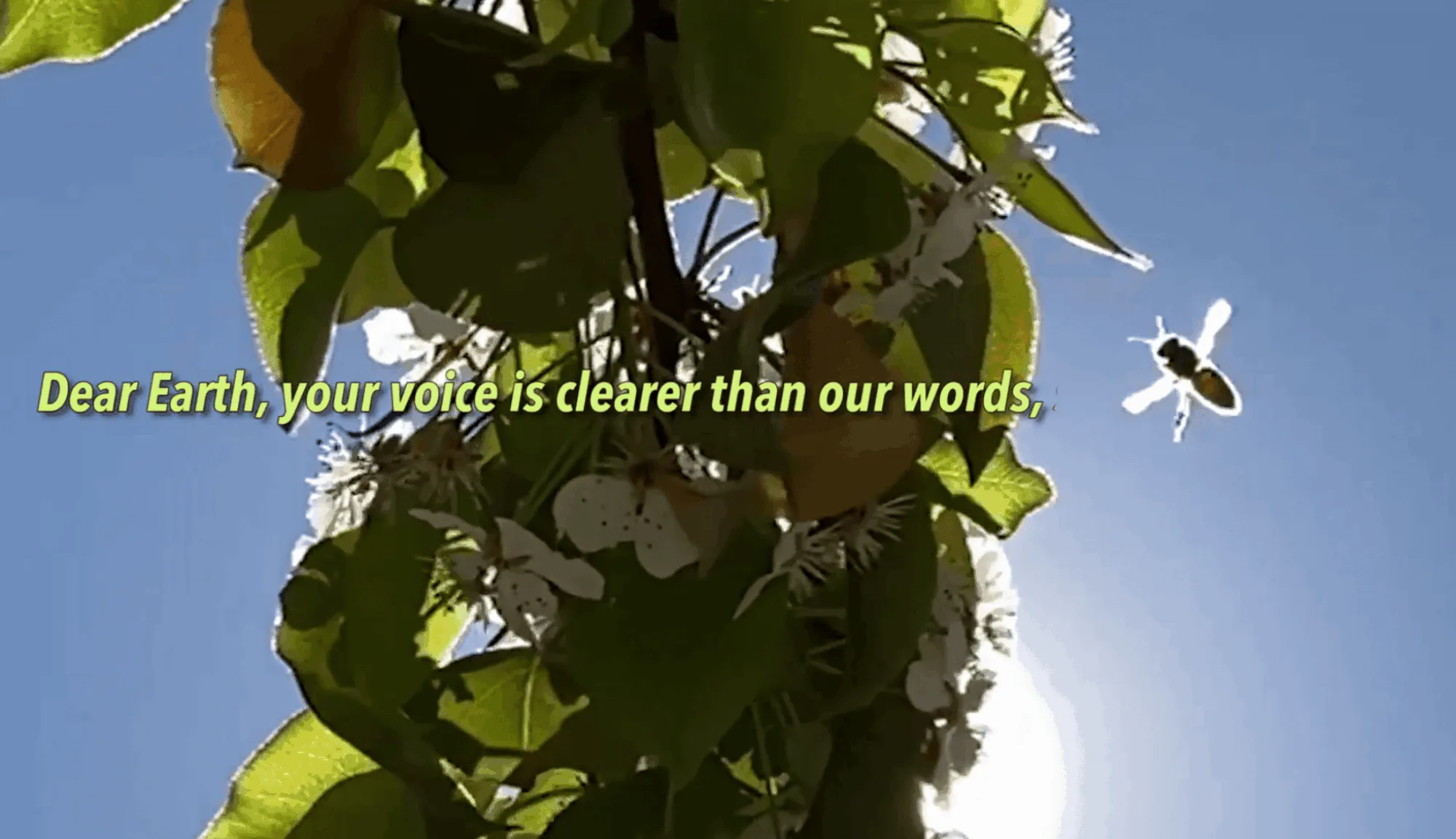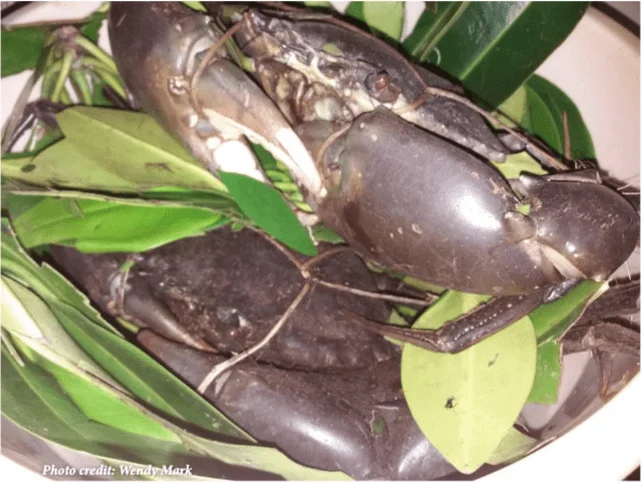
Case Scenario 1: The crabs of Munda (as told by Rev. Cliff Bird, edited for clarity)
Munda is a conglomerate of five small villages in New Georgia, a province in Western Solomon Islands. Munda’s residents depend on the island’s land crabs, which spawn from October to February, as part of their normal diet. Today, their food security is threatened.
During World War II, Japanese forces built a small airstrip at Munda, and following the war it served as a basic commercial airfield. In 2015, the government decided to upgrade the airstrip to an international airport. With financial assistance from the New Zealand government, they expanded the airstrip and airport facilities. The development sits directly in the crabs’ migration path.
When the airport was just a runway, during mating season the crabs would travel to the beach to release their eggs. It was a time of repopulation. It was also the time when people would go to the beach to harvest crabs for food. That was the cycle.
The airport was completed in 2018 and received its first international flight in March 2019. A three-meter-high fence, which is topped by barbed wire and extends underground to prevent animals from digging below it, now surrounds the airstrip. From October 2019 to February 2020, thousands upon thousands of crabs tried to make their way to the sea only to die at the fence. There are also thousands of dead crabs on the road, flattened by increased traffic.
At the two ends of the International Airport there is access to the shore that is not used by the crabs.
Munda’s 10,000 to 15,000 people are highly concerned and want action taken. The crab population has decreased, not only affecting one of their primary food sources, but also having a serious cultural impact. Crab harvesting on the beach is a social activity and a prime opportunity for young men and women to meet. The decrease in crabs has led to a decrease in potential marriages.
I have participated in the harvesting of crabs—my family would go to the beach to fill large buckets. On any given night you will find lines of people three to four kilometers long, collecting crabs. You would see many torch lights. Looking at the given land area, of, say, 400 square meters, you would be looking at about 1,000 crabs in each sample, all heading to the beach. It was quite a sight.
Now, to harvest crabs, residents have to travel further, into the bush, and go through a more complicated process. You have to feel for soft spots in the soil—indicating crab burrows—with your feet. There are also relationships between crabs and the growth of certain plants, and birds. Birds know how to follow the soft paths. The barrier along the runway is disrupting many natural processes, causing a long list of potential damage. All of this could be restored if the airport just removed those barriers.
One of the ways the intemerate baseline can address this case study is for the community to look at the fence’s full impact—ecological, social and cultural—on the community. From a decimated crab population to a decrease in the sale of buckets and torches, the fence has wide-ranging impacts with financial repercussions.
How do we measure this to establish a baseline (either existing data, or memory that can be verified through the triangulation of evidence-based events), The baseline is the x-axis and measured by time and the y-axis is the accounting of the various events.
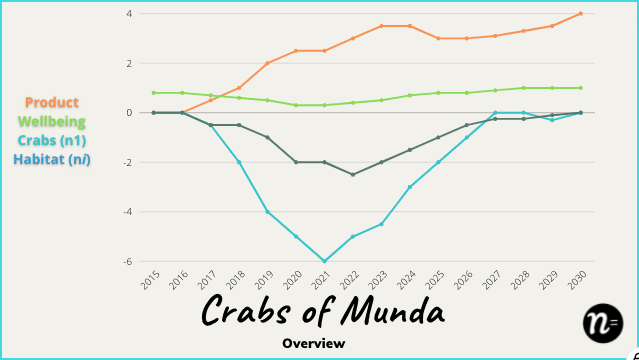
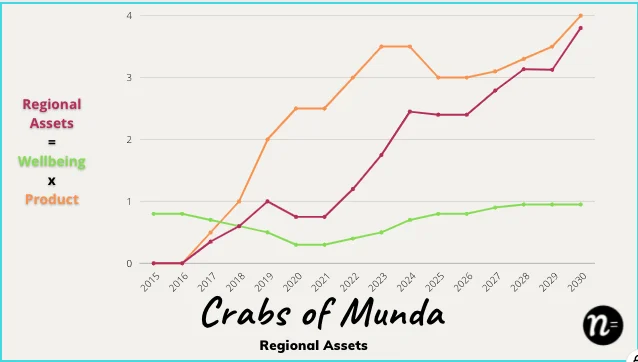
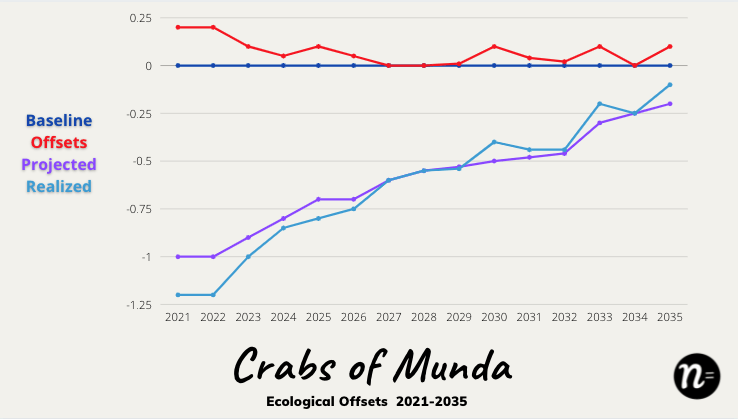
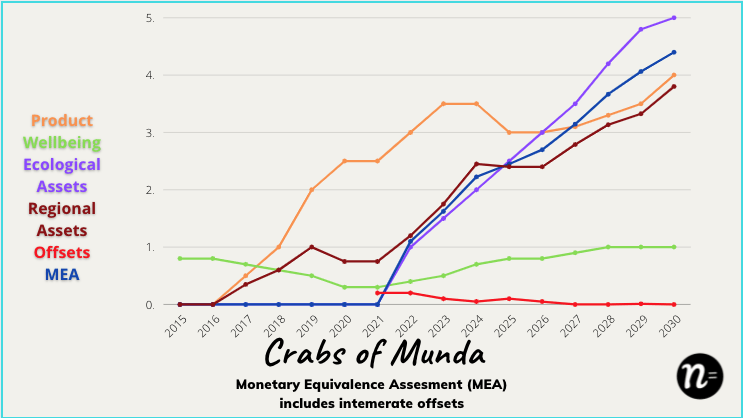
Regionally, Munda has about 140 species of plants; six tree or palm-like species used regularly for food; nine medicinal plants; 11 different trees or palms used for building; and 13 used for tools. In terms of birds, fish, mammals,reptiles, etc. The species of animals are well known and integrated into the biosphere. Restoring the ecological biodiversity of each location requires an indigenous mapping, which can be done according to local methodologies and adhering to strict privacy concerns. The challenge will be in the auditing, which will conform to local consent processes. While not all of these plants and animals pertain to this particular issue, the intemerate accounting process is scalable to accommodate as many indicators as necessary.
In this scenario (figure 1), n1 is the crab population. Included in “habitat” is the population of a bird that may be impacted by the decline of the crab population (n2); the decline of a plant variety that was dependent on the soft soil of the crab habitat (n3); n4, n5 and so on. All of the intemerate variables (ni) are aggregated into habitat. In the overview, the crabs are extrapolated because that was the focus.
If we were only accounting for a product of GDP, we would only be measuring employment, the decline of sales of shovels and buckets and torches and maybe the changes in price to the loss of crabs to the crab market. It’s important to distinguish revenue that is being provided by the airport, as it may not actually benefit the local community as much as it does the developers, private investors, or multinational service contractors.
What may not be obvious is with the promotion of an intemerate accounting scheme, it is the entire community that will know the value of the gains and losses, not just the ones who benefit from an airport job. Also what is unique about this crabs scenario, is that the disruption is simply caused by a fence. How all the stakeholders settle to resolve this can integrate local technologies and solutions with little impact on the product account.
Using the old GDP calculation, an airport provides far more revenue while the loss of land crabs may be simply seen as an external loss. However by including an intemerate accounting model, the gain in revenue for accounting the ecological biodiversity, and the cultural social impacts, provides a clear justification for redesigning and rebuilding the fence to restore access for the land crabs to spawn and return to their natural habitat.
The MEA (Monetary Equivalence Unit) in Figure 4, is based on assumptions. But it is precisely these kinds of variables that we have set as targets in our accounting matrix. In the intermerate equation, Wellbeing (w) is a multiplier of GDP (z). This airport may be relatively benign compared to extractive industries, which may have a greater impact on wellbeing and ecological assets thereby lowering the rate of the MEA to be more closely aligned with, but if the goal is how we transition from an extractive economy to an ecological one, minimizing shocks to the current economy, while creating access and opportunities to impacted or excluded communities, this may be one of the most sustainable program for states and regions to consider.
